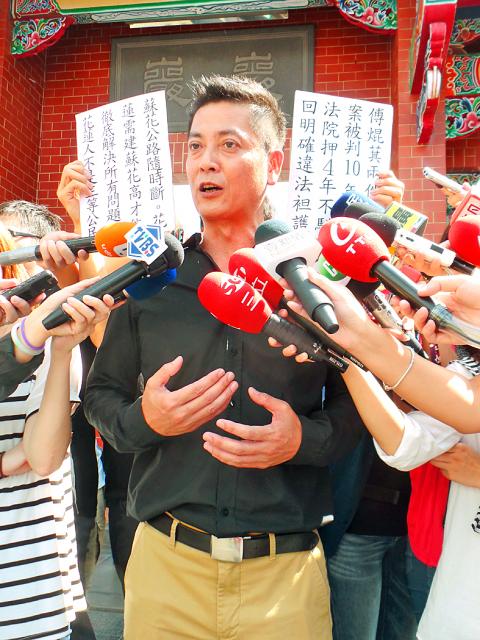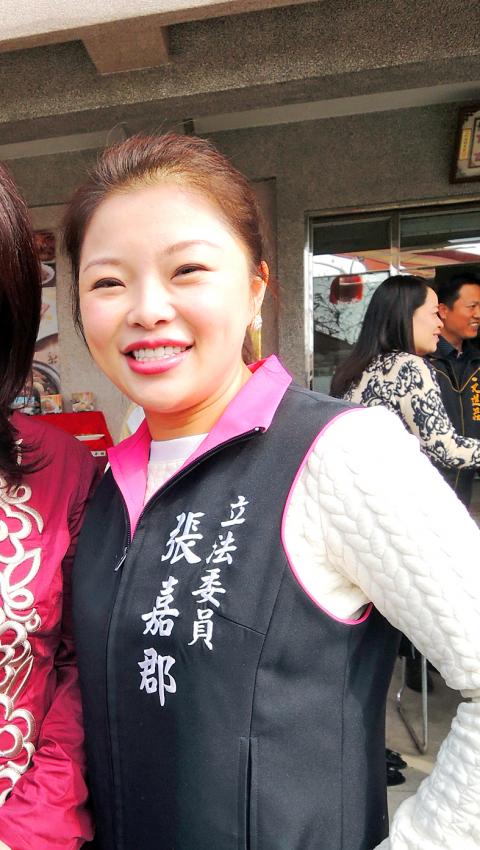Following former Chinese Nationalist Party (KMT) legislator Chang Sho-wen’s (張碩文) announcement of his withdrawal from the party on Monday, two KMT legislators yesterday threatened to do the same, with one saying the cross-strait policy of presumptive KMT presidential candidate Hung Hsiu-chu (洪秀柱) was the source of her misgivings.
Chang, who was also KMT Taipei mayoral candidate Sean Lien’s (連勝文) spokesperson during the campaign last year, released a statement on Monday announcing his withdrawal from the party.
He had said a day earlier that a ruling party “obsessed with a power struggle” is no longer worth supporting.

Photo: Kuo An-chia, Taipei Times
“I decided to leave the party to carry out more efforts that many people expect me to accomplish,” Chang said in the statement, adding that a political party should serve the public, rather than be “a fetter restricting individuals.”
Chang said that he left the party because he “came from the people, and as the KMT is now walking in the opposite direction from the people, I of course have to go back to the people.”
He is said to have planned to run for a legislative seat on the People First Party’s ticket, challenging Democratic Progressive Party (DPP) Legislator Gao Jyh-peng (高志鵬) in New Taipei City’s Sanchong District (三重).

Photo: Liao Shu-ling, Taipei Times
KMT Legislator Chi Kuo-tung (紀國棟), who failed to secure the party’s nomination to run in Taichung, said the KMT “has no regard for party members’ thoughts and deeds.”
After a high-level party member said that it is better to have the party lose members than to have members without a sense of identity, Chi said of course members should have a sense of party identity, but the party has to make itself worth identifying with.
“We do not need enemies when we have members aspiring for a smaller party,” Chi said.
When asked whether he would join the legislative race with another political party, Chi said it is too early to say, as the election is six months away.
However, he also underlined his resolution to run.
KMT Legislator Chang Chia-chun (張嘉郡) said she would consider withdrawing “if the party cannot be an open party, as it said it would be.”
Already nominated by the KMT to run for a third term in Yunlin County, Chang Chia-chun said there is strong opposition at the local level against Hung’s “one China, same interpretation.”
“I myself consider [Hung’s cross-strait policy] an idea that has gone off the track of the KMT’s consensus,” she said.
Chi agreed that Hung’s proposal has had “obvious impacts,” as “same interpretation and respective interpretations are miles apart.”
KMT Legislator Wu Yu-sheng (吳育昇) agreed that Hung has to adjust her cross-strait proposal so it would not harm the party’s legislative election prospects in central and southern Taiwan.
“I cannot blame Chang Chia-chun; I cannot even blame the DPP for categorizing Hung as a ‘unificationist,’” Wu said. “There will be pressure for Hung to make adjustments — and it will not be coming from the DPP, but from the KMT itself.”
Wu added that it is not difficult for Hung to make adjustments to her proposal, as the discussion for setting up reciprocal offices between the two sides of the Taiwan Strait has already been under way; the basic underlying logic of the measure is mutual recognition of one China, but employing different words for it, he said.
Hung simply has to revise the proposal “and make it consistent with the party’s” before July 19, the date of the party congress, Wu said.

US climber Alex Honnold is to attempt to scale Taipei 101 without a rope and harness in a live Netflix special on Jan. 24, the streaming platform announced on Wednesday. Accounting for the time difference, the two-hour broadcast of Honnold’s climb, called Skyscraper Live, is to air on Jan. 23 in the US, Netflix said in a statement. Honnold, 40, was the first person ever to free solo climb the 900m El Capitan rock formation in Yosemite National Park — a feat that was recorded and later made into the 2018 documentary film Free Solo. Netflix previewed Skyscraper Live in October, after videos

NUMBERS IMBALANCE: More than 4 million Taiwanese have visited China this year, while only about half a million Chinese have visited here Beijing has yet to respond to Taiwan’s requests for negotiation over matters related to the recovery of cross-strait tourism, the Tourism Administration said yesterday. Taiwan’s tourism authority issued the statement after Chinese-language daily the China Times reported yesterday that the government’s policy of banning group tours to China does not stop Taiwanese from visiting the country. As of October, more than 4.2 million had traveled to China this year, exceeding last year. Beijing estimated the number of Taiwanese tourists in China could reach 4.5 million this year. By contrast, only 500,000 Chinese tourists are expected in Taiwan, the report said. The report

Temperatures are forecast to drop steadily as a continental cold air mass moves across Taiwan, with some areas also likely to see heavy rainfall, the Central Weather Administration (CWA) said. From today through early tomorrow, a cold air mass would keep temperatures low across central and northern Taiwan, and the eastern half of Taiwan proper, with isolated brief showers forecast along Keelung’s north coast, Taipei and New Taipei City’s mountainous areas and eastern Taiwan, it said. Lows of 11°C to 15°C are forecast in central and northern Taiwan, Yilan County, and the outlying Kinmen and Lienchiang (Matsu) counties, and 14°C to 17°C

STEERING FAILURE: The first boat of its class is experiencing teething issues as it readies for acceptance by the navy, according to a recent story about rudder failure The Hai Kun (海鯤), the nation’s first locally built submarine, allegedly suffered a total failure of stern hydraulic systems during the second round of sea acceptance trials on June 26, and sailors were forced to manually operate the X-rudder to turn the submarine and return to port, news Web site Mirror Daily reported yesterday. The report said that tugboats following the Hai Kun assisted the submarine in avoiding collisions with other ships due to the X-rudder malfunctioning. At the time of the report, the submarine had completed its trials and was scheduled to begin diving and surfacing tests in shallow areas. The X-rudder,